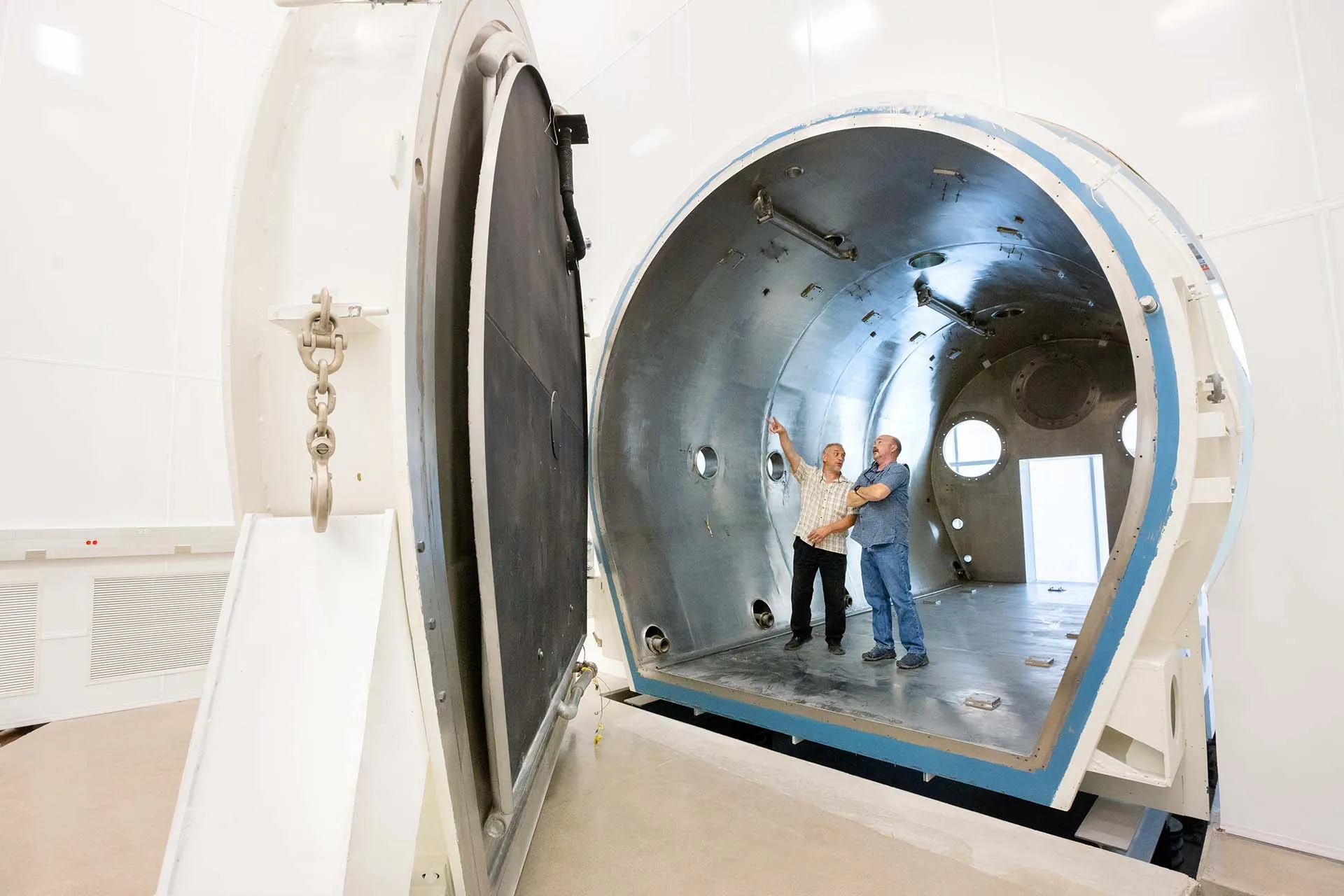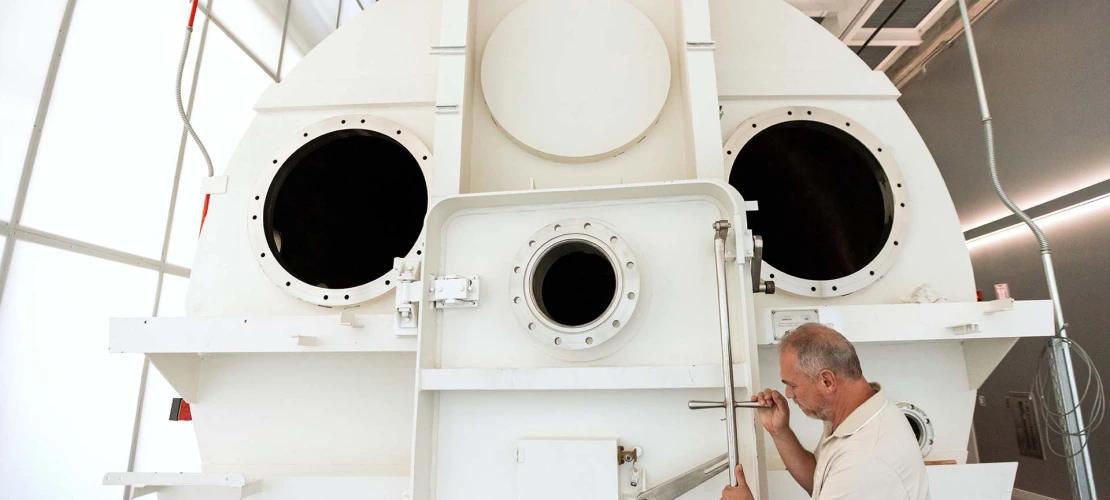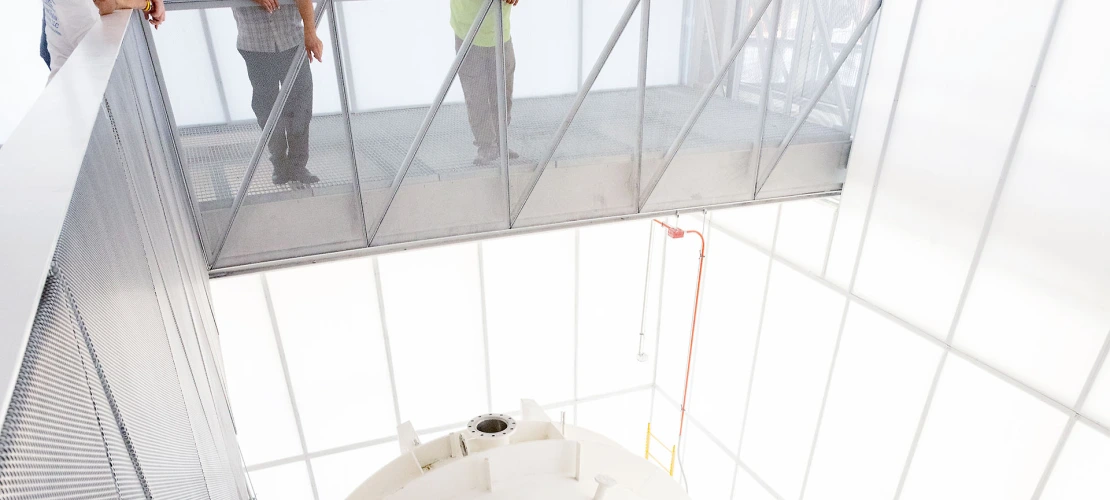Exploring New Frontiers Of Space
The new Applied Research Building houses flight testing for balloons and satellites.

Steward Observatory staff members Ruben Dominguez, a senior mechanical engineer, and Brian Duffy, a project manager, examine the thermal vacuum chamber at the university’s new Applied Research Building.
Chris Richards
The University of Arizona celebrated the grand opening of its dazzling three-story, $85 million Applied Research Building in early April. Located on Helen Street, this edifice of shimmering glass and metal with International Space Station-inspired fins will serve as a cutting-edge home for the Arizona Space Institute. It’s the nation’s first integrated facility to house everything from space debris analysis to an anechoic chamber for antennae command, control and data-relay testing all under one roof.
The project marks a profound commitment to the future, as UArizona President Robert C. Robbins noted before the celebratory crowd. “You can’t translate research into applied science,” he said, “without an investment in fundamental discovery.”
Among other features, this particular investment includes a fabrication lab for cereal-box-sized satellites called CubeSats, a curation facility for differentiating between space junk and natural objects like meteorites, and a 40-foot-high bay for assembling stratospheric balloons used for everything from weather mapping to NASA missions.
The new building is also home to a 30-foot-long, 81,000-pound leviathan called a thermal vacuum chamber. This formidable device is big enough to hold a pickup truck, but its primary mission is testing space-based satellites and balloon payloads in conditions similar to space. Within the chamber, satellites will be subjected to enormous pressure and temperatures topping 150 degrees Celsius or dipping below minus 190. This testing not only provides precious data for research but also safeguards enormously expensive spacecraft from unforeseen flaws.
Think of it in terms of car-buying. Would you purchase a new car that’s never traveled beyond the factory floor — never been checked for leaky seals or wheezy gaskets or highway handling? Probably not.
Now imagine launching a $50 million satellite without knowing whether it can withstand the extreme rigors of space. Far better to give it a “test drive” in the thermal vacuum chamber first. Even at a cost of about $12,000 a day, that’s a bargain, according to Ruben Dominguez. He’s a senior mechanical engineer with Steward Observatory, the astronomy department’s research arm.
“The cost to run a thermal vacuum test is well worth it,” he says. “If your satellite doesn’t work while it’s up in space, then you just lost a million dollars or more — compared to testing, which is about a tenth of that.”
The chamber likewise simulates the extraordinary pressure drops that balloons experience when going from sea level to altitudes above 100,000 feet. In the chamber, pressure is manipulated by vacuum pumps, Dominguez says. “It will also simulate temperature change,” he continues. “We launch balloons mostly from Antarctica, where the temperature will be right above zero Celsius. Then the balloon payload goes up through the atmosphere; at 50,000 feet, the temperature drops to about minus 50 Celsius, and at 120,000 feet, the temperature is about minus 10 Celsius. The chamber does all of that in a process that takes about 2 ½ to three hours.”
In short: very important testing achieved by highly specialized machines. Of course, you could only dream of your car retaining the value of these coveted thermal vacuum chambers. This one, which is 34 years old, was purchased from aerospace giant Northrop Grumman for around $1 million. It’s being retrofitted with the latest equipment — including modern vacuum pumps that are oil free, lessening the potential for contamination of satellites — and the cryoshrouds that produce those stunningly low temperatures.
Despite the high demand for such testing devices and the proceeds they can generate, this chamber brings far more value to the university than just revenue. There are also the intellectual profits from being a part of so much high-level testing. “Since we are getting a lot of projects for space, our researchers and students here will also be learning a lot,” Dominguez says.
“Reports are usually done after a satellite is tested inside the chamber,” he continues. “Some of them are classified, so you’ll never know about it. But the majority of them are published in journals, which we can all continue to learn from.”
Now that’s a fundamental investment indeed.



